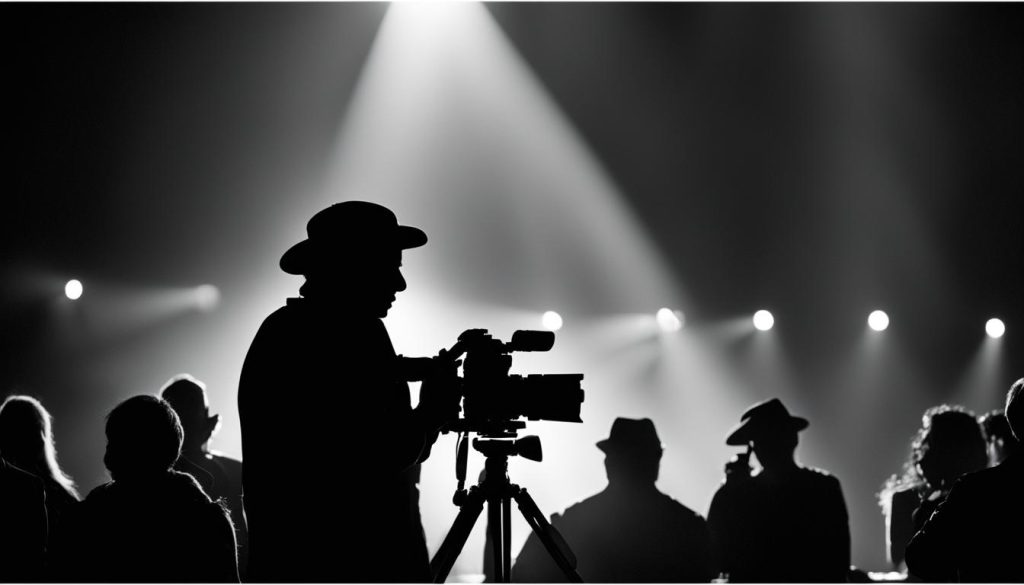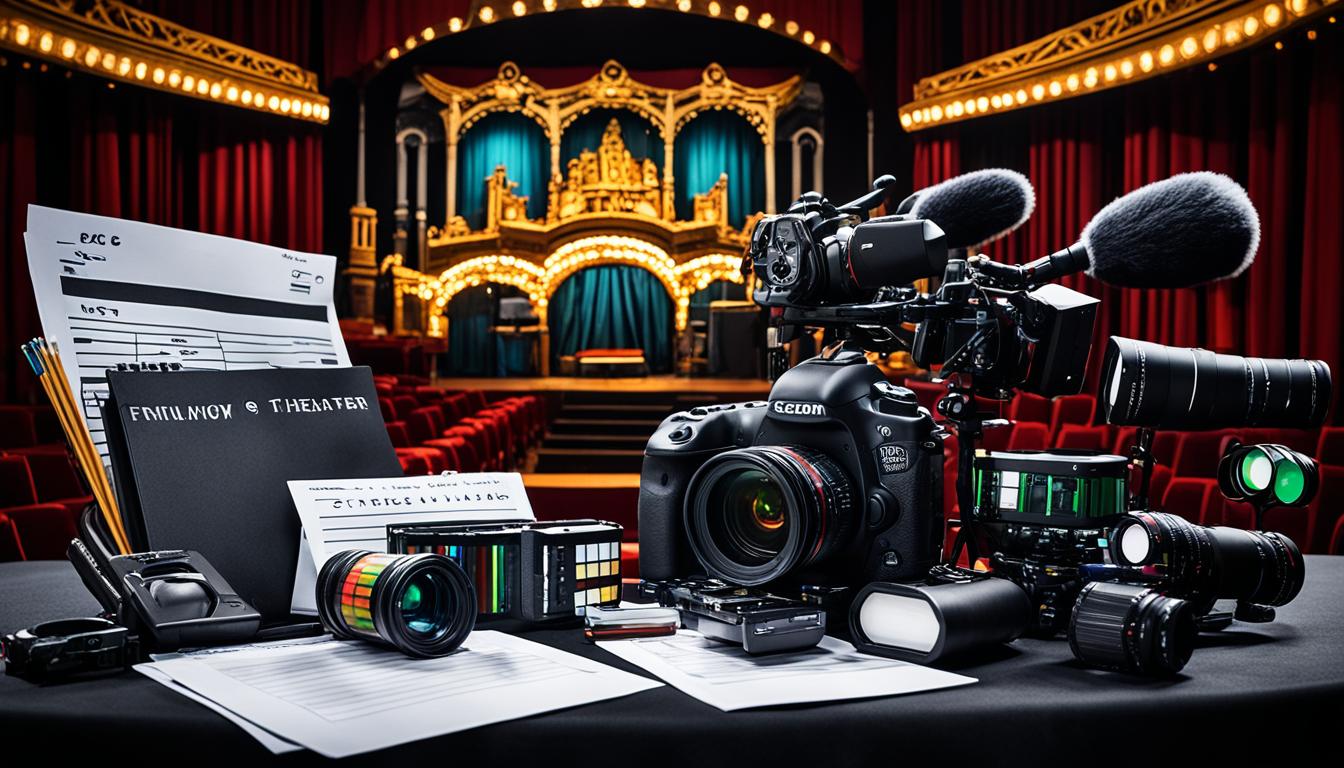Are you passionate about theater photography but struggling to capture the perfect moments? Look no further! In this section, we bring you essential theater photography checklist tips to help you create stunning images that capture the essence of theater performances. These tips will ensure you are well-prepared for a standing ovation-worthy shoot.
Key Takeaways
- Knowing the show and venue is crucial for theater photography.
- Using the right equipment, like a high-quality DSLR camera and fast lens, can help you get the perfect shot.
- Mastering your camera settings is essential to capturing theater photography.
- Capturing emotions and expressions adds depth and meaning to your theater photography.
- Timing is everything when it comes to capturing the perfect shot.
Know the Show and Venue
Before you capture stunning photographs of a theater show, it’s crucial to familiarize yourself with the production. This includes understanding the storyline, characters, and key moments that will help you anticipate the best shots. In addition to getting to know the show, it’s also important to become familiar with the venue’s layout and lighting conditions. This will allow you to plan accordingly and choose the right equipment and camera settings to perfect your shots.
For example, some theater venues have limited lighting conditions or unique stage layouts that can impact your photography. By knowing the venue beforehand, you can adjust your equipment and settings accordingly and avoid common issues, such as blurry or underexposed shots.
Getting to know the show and venue is an essential foundation for successful theater photography. By taking the time to research and explore, you’ll be well-prepared to capture stunning images that showcase the drama, emotion, and beauty of every performance.
Use the Right Equipment
One of the most important aspects of theater photography is having the right equipment. To capture sharp and well-exposed images in low-light conditions, invest in a high-quality DSLR or mirrorless camera with good low-light capabilities. You should also use a fast lens with a wide aperture, such as f/1.8 or wider, to let in as much light as possible.
When shooting theater performances, consider bringing a tripod or a monopod to ensure stability during longer exposures. This is especially important if you plan on using slower shutter speeds to capture motion blur or if you have heavy equipment.
Carry spare batteries and memory cards to avoid running out of power or space in the middle of a show. By having the right equipment, you’ll have more control over your shots and be able to capture even the most challenging moments.
Master Your Camera Settings
Understanding your camera’s settings is essential for capturing stunning theater photography. To ensure that you take excellent shots during performances, you need to set your ISO to a higher value to compensate for the low light without making your photos noisy. The shutter speed of your camera also plays a significant role in capturing movements, and it’s essential to experiment with different speeds to freeze motion or create intentional blur. Also, adjust your white balance to match the stage lighting for even more fantastic shots.
And remember, always use manual focus for more control over your shots. Take your time and adjust the focus until you get the perfect shot. With these settings, you’ll be able to add a unique depth of field to your shots!
Pro Tip: Spend some time before the performance to test the different camera settings and the effect they have on your photos. This way, when the performance starts, you’ll be ready to capture even the most challenging shots.
Capture Emotions and Expressions
When capturing theater photography, remembering to capture the raw emotions and expressions of the performers can help convey the essence of the scene. By focusing on their facial expressions, body language, and gestures, you can create a dynamic and lively representation of the show. Searching for moments of vulnerability, joy, or intensity can help bring the characters to life in your images.
Make sure to pay close attention to the lighting and positioning of the performers to really capture their emotions. Utilize a high-quality lens with a wide aperture to keep your images sharp and well-exposed in low light conditions. Take your time to look for the right moments of the performance to truly capture the essence of the story being told.Capture the emotions and expressions to truly convey the power of theater photography.
Find the Ideal Shooting Positions
To make the most of your theater photography, you need to find the ideal shooting positions. This will allow you to capture unique perspectives and add variety to your shots.
Start by exploring different angles by moving around the venue. Get creative and look for unique positions from the side, front, or even backstage area. Experiment with shooting from different heights to add depth and dimension to your images.
When finding the right shooting positions, be considerate of the performers and the audience. Avoid blocking anyone’s view and use quiet camera equipment.
Remember, the goal is to capture the essence of the performance from different angles and perspectives. With the right shooting positions, you can take your theater photography to the next level.
Timing is Everything
As the saying goes, timing is everything! In theater photography, this couldn’t be more true. You need to anticipate the key moments in the performance and be ready to capture them with your camera. Keep an eye out for dramatic gestures, emotional scenes, or striking visuals that can make for a captivating photo.
But remember, patience is also key. Sometimes, you may need to wait for the perfect timing to press the shutter button and freeze that captivating moment. Don’t rush and take your time, so you can capture the essence of the performance in your photos.

One way to be prepared for perfect timing is to practice your timing skills during rehearsals and other performances. This can help you get a better sense of when and where to aim your camera and when to press the shutter button to achieve the perfect shot.
Conclusion
As a theater photographer, you have the unique opportunity to capture the magic of live performances through your lens. By following these essential checklist tips, you’ll be well-prepared to take stunning photographs that convey the emotions and expressions of the performers, as well as the overall atmosphere and mood of the show.
Remember to take the time to familiarize yourself with the production and venue, choose the right equipment, master your camera settings, and find ideal shooting positions. Patience and timing are also key elements in theater photography, so be ready to anticipate and capture those perfect moments that will truly capture the essence of the performance.
With these tips, you’ll be able to create unforgettable images that showcase the beauty and power of theater. So grab your camera and get ready to create your own standing ovation-worthy photographs!






